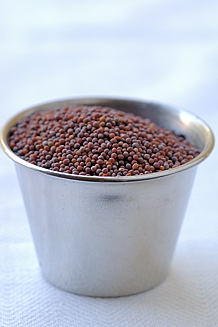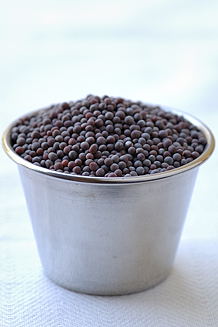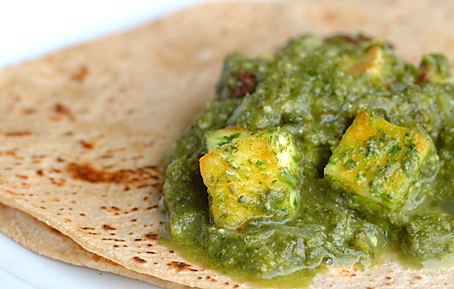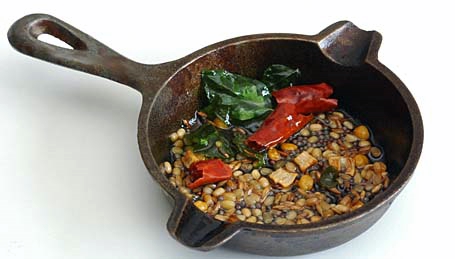

Tiny Brown Mustard Seeds from Andhra Pradesh also Known as “Chitti Aavalu” in Telugu
and Black Mustard Seeds from Bharath
According to old-world tales, there was an interesting exchange of messages between King Darius of Persia and Alexander the Great.
King Darius sent a sack of sesame seeds to Alexander to show the vastness of his army. To this, Alexander responded with a sack of mustard seeds to imply not only the number but also the power, energy and the fiery nature of his men.
Mustard seeds are one of the oldest spices known to mankind and valued for their antiseptic, antibacterial, carminative and warming properties. They are also good source of omega-3 fatty acids, iron, calcium and protein. Mustard greens are an excellent source of Vitamin A, iron, zinc and improve blood circulation.
Mustard is a very economical plant. Its leaves are used as a vegetable, flowers and pods in salads and seeds as a spice. Mustard seeds hardly give away any fragrance when whole. This is because the enzyme that creates the hot, pungent taste of mustard is activated when it comes in contact with liquids. And for this very reason we wait for the mustard seeds to pop in our tadka. The popping of mustard seeds imparts the sharpness and nutty flavor to the dish.
The vibrant yellow flowers of mustard plants shout out the impending arrival of spring to the world. Folks in Punjab celebrate Basant Panchami when spring arrives with amazingly beautiful, bright and cheery rolling fields of mustard. A favorite of Bollywood films, fantastically yellow mustard fields are breathtaking and romantic. When you talk about mustard and Punjab, it is only natural that one thinks of “Sarson Ka Saagâ€Â. This one of a kind dish is best enjoyed with Makke de Roti (corn roti).

Toasted Mustard Seeds, Part of Traditional Tadka or Popu

There are three types of mustard seeds – white (actually they look more yellow than white), black and brown. Brown mustard looks very identical to black mustard but has only 70% of the pungency. Mustard seeds are harvested when the pods are fully developed but not yet ripe. The mustard hay is then stacked to dry and then threshed to remove the seeds.
Oil of mustard is a rubefacient. It irritates the skin when applied and dilates the small blood vessels underneath the skin. This increases the flow of blood to the skin and makes it feel warm. Mustard plasters are used to relieve chest colds and coughs. To make a mustard plaster, mix some powdered mustard with warm water and spread it as a paste on a doubled piece of soft cloth. Do not apply this plaster directly on the skin. Take care to see that you don’t keep it on for more than 15 minutes.
A mustard foot bath is a traditional remedy for colds and headaches. Add one teaspoon of mustard powder to a bowl of hot water and soak your feet for about 15 min. The warming nature of mustard clears the congestion by drawing it away from the source. These foot baths or mustard plasters should be used carefully since mustard can irritate skin if used for longer durations. Also never use this remedy on small children.
I have read that it is fairly easy to grow mustard. If you plan to try it, make sure you choose a sunny area in your yard. Mustard is an annual plant and germinates easily. It spreads easily too so you just need to make sure that it doesn’t take over your entire yard.
I just loved the idea of harvesting our own mustards seeds, like this gardener had done and I am going to give it a try this year. Only time will tell whether I can actually get substantial amount of mustard seeds from my garden or not, but I will at least get a small piece of Punjab with beautiful and bright yellow flowers.
Guest Article by ~ Anjali Damerla of Supreme Spice
Photography by: Indira Singari
If you have questions about Mustard spice, please post them in comments section. Anjali would be glad to answer them for you. Thanks.

Hi Indira,
Nice and informative post Indira and Anjali. Good historical story about mustard. Like the story though.
I didn’t know that it has omega-3 fatty acids…which is abundant in fish. I have a assumption that if we eat more mustard or powder It will warm or heat our body? Is it really true?
..When I was a child my parents never bought mustard for household use. We used to grow along with urad dal field. I remember playing in those fields…may be someday I’ll grow this in backyard.
Thanks for the nice post Indira and Anjali.
Comment by laxmi — September 13, 2007 @ 6:10 pm
Indira,
Thanks for this novel idea, have never thought of this!..I love mustard especially being from coastal andhra – aava pettina kura – is a delicacy and a regular feature in our house. My brother is a big fan of mustard oil w Avakaya – I remember the warnings flying as soon as the topic arose – After coming to US, I do use it a lot to fight off cold in the body. I will definitely try this.
Thanks for bringing this unique feature- Hats off to both of you! – Aparna
Comment by Aparna — September 13, 2007 @ 6:21 pm
a very informative post on mustard.
Comment by roopa — September 13, 2007 @ 9:06 pm
I love all that info you share in your each post…simply mind blowing! Never thought that tiny mustard seed has such strong background. Loved the blog of green thumb too!
Comment by Padma — September 14, 2007 @ 5:50 am
the story you narrate about mustard seed is very interesting – i love gathering stories about spices we use. i knew this buddhist story about a grieving mother’s search for mustard seed which is associated with the first of the eightfold path – right understanding.
Comment by lakshmi — September 14, 2007 @ 6:06 am
Indira,
never ever thought mustard could have such a history,uses.. omg!! that was the last thing which used to be in kitchen pantry,well not
any more!!!!.thanks for the lovely post.
cheers
rasshmi.
Comment by Rasshmi — September 14, 2007 @ 6:34 am
This post was so informative, I was hoping that you could answer another question I have. What is the difference between white and dark mustard seeds, in terms of flavours? I’ve come across some recipes that specifically call for white, without saying why. (Also, I’ve switched from using only dark mustard to only white because the dark variety always seems to have stones and sand, whereas the white is clean, and want to know if the change will make a difference in taste / flavour.)
Thanks.
Comment by vasudha — September 14, 2007 @ 6:38 am
Anjali/Indira,
thanks for the insight into this wonderful spice. I should try to grow mustard.whats the best time to plant ?
Comment by sreelu — September 14, 2007 @ 8:42 am
Hi Vasudha,
The white mustard seeds are milder and less pungent compared to the brown & black ones. But, on the other hand, they seem to have more moisture absorbing properties than the other two.
Comment by Anjali — September 14, 2007 @ 11:55 am
Hi Sreelu,
Sow seeds in early fall.They prefer cool weather so Sept-Oct would be a good time. But make sure that they are in full sun and get plenty of water. They mature fairly quickly (abt 45 days).
Comment by Anjali — September 14, 2007 @ 12:01 pm
Your posts are always so informative and rich.
We get both kinds of the mustard seeds you featured, imported in these parts.
Comment by Cynthia — September 14, 2007 @ 7:50 pm
Hi dear Anjali,
Thanks a lot for linking my mustard post as a reference in your very informative post.
Although I have been growing mustard in my home garden, a lot of info about mustard in your blog was news to me. Now I will use my home grown mustard with lot more pride.
Comment by green thumb — September 16, 2007 @ 11:20 am
I have the same question as number 7. What IS the difference between white & brown mustard? I am going to can some green tomato relish tomorrow, & it calls for white mustard, which I couldn’t find at my regular grocery store. This is a receipe my grandmother used & I loved, but, she is no longer with us, so, I cannot ask her. She was the only one in the family to make it.
Thank you for any info you can give me.
Joan
Comment by Joan Burke — October 20, 2007 @ 9:47 pm
hi there
I have a prawn curry recipe and it requires a teaspoon of black mustard seeds, which I cant get hold of can I use yellow instead?
Comment by katrina — December 18, 2007 @ 8:11 am
Arey wah! That was pretty informative ya! I had no much clue about the other side of Mustard as you informed. Wasise aap ko pata hai, during holi, my neighbours would make a mustard paste and keep it overnight. After our splurge of colours, each of us would get a share of the paste which we would rub on our skin and get rid of the colours. Ekdum mast idea thaa :=)
Comment by AJ — February 21, 2008 @ 10:58 pm
Hello!
Comment by without — September 27, 2016 @ 10:17 am